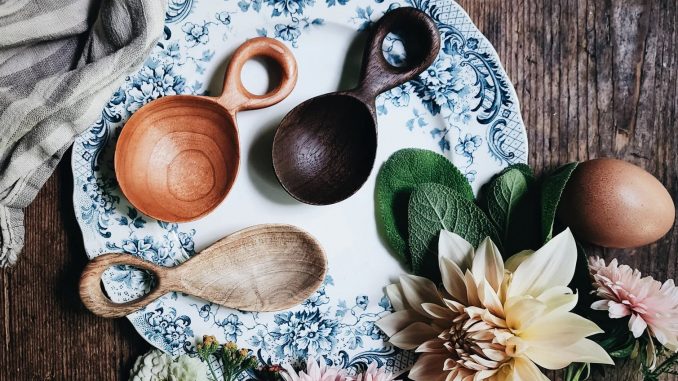
In 2009, the Polder family decided to become farmers. At the time, they were living on a half-acre property in Melrose, Florida, and had no prior farming experience. They made the small space work for them, raising rabbits, making jams, and selling them both locally.
Today, the Polder family lives and works on a 115-acre farm, where they run a successful handcrafted wooden home-goods business. The majority of their sales comes from their own Shopify store, but it wasn’t always this way. Old World Kitchen made its living offline before launching an ecommerce presence on Etsy.
The family credits Etsy with getting their start online, but moving to Shopify in order to scale was critical to their growth. When the Polder family made the shift, they increased conversion, expanded to resale goods, and built an owned email list.
Here, the family’s business manager, Loran Polder, speaks about her family’s journey and the benefits of moving beyond the marketplace.
Meet Old World Kitchen
After dabbling in basket weaving, blacksmithing, and leather work, Loran’s dad, Trevor, found his stride with woodworking. The family began selling his handcarved wooden spoons at local farmers markets, garnering positive reception. The success of the spoons prompted the family to pursue the farming business in a serious way.
“We just went for it,” says Loran of the family’s early days. “We certainly weren’t getting rich doing it, but it was moving in the direction of our dreams.”
You just don’t see people bringing this kind of product to your doors these days.
The Polder family then packed their bags and moved to a larger farm property in Tennessee, adding dairy cows and beekeeping to their scope. True to their Old World approach, their initial sales channel was also a throwback. The Polders packaged their honey and handmade goods into gift baskets, and sold them door to-door. “You just don’t see people bringing this kind of product to your doors these days,” says Loran.
The Polders found surprising success with the approach, but it was time consuming and unsustainable. That’s when a neighbor suggested an Etsy store. But at the time, the family didn’t even own a home computer. “We were actually going to the local library to check emails,” Loran says.
“We knew nothing about marketing,” says Loran. “It just seemed to us, sheltered as we were, that you put up a website and people got to it somehow.” The main benefit of a marketplace, however, is that high-intent buyers are built in. And three days after launching, they made their first sale. “That was hugely encouraging to us,” says Loran.
Building a brand on their own terms
It was when a pop-up opportunity landed on their plate that the Polder family realized they hadn’t invested enough in their actual brand. As they imagined their brand materializing in a physical way, it helped them hone in on their message and vision for the company as a whole.
The investment in their brand led to even more success—until the family hit the peak of their handmade production capacity. That’s when they asked themselves: How do we scale?
I think that a lot of crafters have this idea that you have to be the poor struggling artist, like there’s something wrong with figuring out how to make your business profitable.
The family considered investing in a CNC machine to create another line of wooden spoons at a lower price point. The move, however, would contradict the brand’s by-hand ethos. The alternative? Increase their prices. “I think that a lot of crafters have this idea that you have to be the poor struggling artist,” says Loran, “like there’s something wrong with figuring out how to make your business profitable.”
Their customers are happy to pay the higher prices for products rather than buy from other producers selling comparable products at a fraction of the cost. That’s because the family behind Old World Kitchen isn’t selling just a spoon. They’re selling a way of life, their story, and an experience.
As their brand grew, and their prices became more aligned with a luxury brand, the Polders found Etsy could no longer meet the needs of their growing business. Loran felt the typical Etsy shopper—younger and more budget conscious—was no longer their target audience.
The Polders began to grow their social channels in an effort to build a customer base outside of Etsy. In the meantime, they upgraded their camera and learned photo software to drastically improve their ecommerce photography. When they were ready to move away from Etsy, they tried other ecommerce platforms before landing on building a new store on Shopify.
The new Old World Kitchen
Moving from Etsy to a new store on Shopify was a game changer. “We were just absolutely blown away, because our conversion rate went up so much,” says Loran.
While the family needed to learn marketing on the fly, the efforts meant their visitors were high-intent. “There’s a huge amount of distraction on Etsy,” Loran says. “It’s more like strolling through a crafts fair rather than intentionally driving up to a brick-and-mortar store.”
Old World Kitchen held firm with the new prices and continued to grow a following. The new pricing model allowed it to scale while staying true to goods made by hand. Each year, as they continue to hit the ceiling of their production capacity, the family regroups to decide how they can continue to grow while maintaining brand integrity.
One of those strategies was partnering with other brands as resellers—another avenue of growth that would not have been possible with Etsy. Now, complementary products like cast iron cookware and tea towels are available in the store.
When (and why) to move from Etsy to Shopify
Loran credits Etsy for getting the family’s business off the ground. The platform was the perfect place to experiment with ecommerce, learn about online customer service, and bring their product to an existing audience.
Eventually they outgrew it.
The freedom and flexibility of running a business on Shopify lets them scale their business and automate a lot of Old World Kitchen’s commerce processes, while also focusing on what they do best: making.
When to migrate from Etsy to Shopify and build your own ecommerce store depends on your goals, growth rate, and the features your business needs from a platform.
As a store owner, you might be ready to move your handmade business and open a new Shopify store if:
Migrate from Etsy to Shopify and try us free for 14 days
In a lot of cases, businesses elect to keep their Etsy shops active even while growing a Shopify store. It’s a tactic the Polder family employs, using their Etsy store as a secondary sales channel.
A business for generations to come
 Today, Loran handles all of the tasks involved with keeping the online store running, including everything from social media to email marketing. Her younger sister manages the shipping and fulfillment, while most of the family makes up the production team, with Trevor at the helm. Matriarch Angela Polder heads up quality control. “If anybody’s slacking, she makes sure they know it,” says Loran.
Today, Loran handles all of the tasks involved with keeping the online store running, including everything from social media to email marketing. Her younger sister manages the shipping and fulfillment, while most of the family makes up the production team, with Trevor at the helm. Matriarch Angela Polder heads up quality control. “If anybody’s slacking, she makes sure they know it,” says Loran.
Old World Kitchen is a business designed to support generations to come, with room to incorporate future spouses and children into the mix.
The Polder family’s own story is one and the same with the brand. Being able to tell it on every page of their own site is critical to the success of their business and the preservation of their legacy.
Moving from Etsy to Shopify FAQ
What’s the difference between Etsy and Shopify?
Etsy and Shopify are both ecommerce platforms that let you sell products and run your business online. But they have key differences:
Etsy is a marketplace for handcrafted products, vintage goods, and select maker-developed manufactured goods. An Etsy store lives within a set template, and items are searchable within the marketplace. Communication with buyers is built into the messaging feature within the platform.
Shopify is a commerce platform that allows merchants to sell through an online store, at a physical location, via social media, and everywhere in between. Your Shopify store is your own. It lives on your own domain, reflects the individuality of your brand, and allows the flexibility to choose a plan and price tier that best supports your business needs. You have full control over your marketing with tools inside Shopify.
Can I move my Etsy shop to Shopify?
Yes, you can move from Etsy to Shopify entirely or manage them as two separate sales channels. For the former, use an Etsy migration tool to import data and products into Shopify. If you plan on maintaining both channels, an app like Etsy Marketplace Integration can sync your products and sales from your online store and your Etsy store to help you manage everything in one place.
What are the steps to migrate from Etsy to Shopify?
This is a step-by-step guide to migrating your data from Etsy to Shopify:
There are a number of other apps in the App Store that can help you import or sync your data across the platforms.
When should you make the switch from an Etsy store to a Shopify store?
You may be ready to make the move from Etsy to Shopify if your brand has built a substantial following and you think you can drive traffic to a standalone ecommerce site. Other signals that it’s time to move include: the need for additional site functionality, interest in curating products from other brands, the desire to build an email list, or a shift in business model.
What are the benefits of moving from Etsy to Shopify?
The benefits of moving from Etsy to Shopify and building your own site include the ability to:
Photos courtesy of Old World Kitchen

Leave a Reply